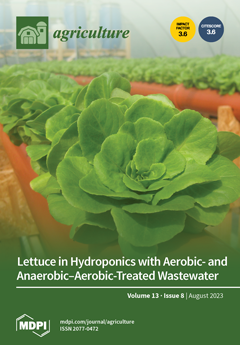This paper aims to find a fertilization method that better matches the growth characteristics of vegetables and reduces the soil and environmental problems caused by unreasonable fertilization methods, in view of the strong buffering of the clayey black soil in the north and the mismatch between the amount of chemical fertilizer applied and the growth characteristics of vegetables during cultivation. In this experiment,
Lactuca sativa L. (
Lactuca sativa) was studied in a randomized complete block design in greenhouse and five different fertilizer application methods were arranged: exponential fertilization (EF), linear fertilization (LF), average fertilization (AF), one-time fertilization (OF), and no fertilization as a control group (CG). The effects of different fertilization methods on soil nutrients, agronomic traits of
Lactuca sativa growth, and related quality were investigated, and the pattern of effects of different fertilization methods on growth and soil nutrients was obtained. The results of the experiment showed that the exponential fertilization method gradually took advantage as the growth time extended. The plant height (PLH), leaf length (LL), leaf width (LW), yield, soluble protein (SP), soluble sugar (SS), vitamin C (VC), and elemental nitrogen (EN) and potassium (EK) of
Lactuca sativa were significantly improved under the exponential fertilization method compared with other fertilization methods, by 29.9 cm, 51.5 cm, 5.96 cm, 22, 2.32 kg/m
2, 0.23%, 0.44%, 3.93%, 94.66 mg/kg, 1.58 g/kg, and 1.94 g/kg, respectively. The alkali-hydrolyzed nitrogen (SAN), available phosphorus (SAP), and available potassium (SAK) in the soil after fertilization were 139.69 mg/kg, 50.23 mg/kg, and 180.30 mg/kg, respectively. The above results showed that the exponential fertilization method not only improved the quality of
Lactuca sativa and thus the quality of the crop growth traits, but also changed the soil nutrients favorably after fertilization, which is of some importance for the protection of black soils.
Full article
 to open them.
to open them.




